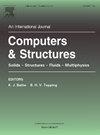面向层对层增材制造过程局部热积累的三维结构拓扑和双材料分布同步优化
IF 4.4
2区 工程技术
Q1 COMPUTER SCIENCE, INTERDISCIPLINARY APPLICATIONS
引用次数: 0
摘要
本文介绍了一种基于拓扑优化(TO)模型的增材制造(AM)中有效分配材料相以最小化结构顺应性和增强局部热排出的新方法。在逐层生产过程中,该方法同时优化了结构的预期功能和行为。虽然增材制造允许复杂的、拓扑优化的多材料设计,但它经常引起高温和热通量,有零件失效和损害机械性能的风险。为了解决这个问题,提出了一种基于三维梯度的双材料和功能梯度的To方法,考虑了总体积百分比和基于局部子域温度的热约束。该方法涉及基于密度的多材料TO,在提出的固体各向同性材料扩展的基础上,用惩罚法插值弹性模量、导热系数和热流密度。随后,模拟AM过程,对每个顶层元件层暴露于热流场的子域进行稳态分析。二维和三维数值结果都证明了所提出的方法在防止AM中局部加热引起的几何图案方面的贡献。此外,在双材料和功能梯度材料设计中,该方法可以有效地产生卓越的设计,而无需牺牲支撑结构,提供自支撑结构。本文章由计算机程序翻译,如有差异,请以英文原文为准。
Simultaneous optimization of topology and bi-material distribution of three-dimensional structures for addressing local heat accumulation in layer-upon-layer additive manufacturing process
This paper introduces a novel approach based on a topology optimization (TO) model to efficiently distribute material phases for minimizing structural compliance and enhance local heat evacuation in additive manufacturing (AM). The approach simultaneously optimizes the structure for its intended function and behavior during layer-by-layer production. While AM allows intricate, topologically optimal multi-material designs, it often induces high temperatures and heat fluxes, risking part failure and compromising mechanical properties. To address this, a 3D gradient-based bi-material and functionally graded TO method is presented, considering total volume percentage and a thermal constraint based on temperatures of local sub-domains. The methodology involves density-based multi-material TO, interpolating elastic moduli, thermal conductivity, and heat flux based on proposed extensions of solid isotropic material with penalization method. Subsequently, a steady state analysis is performed in each sub-domain whose top element layer is exposed to a heat flux, simulating AM process. Both 2D and 3D numerical results demonstrate the contribution of the presented approach in preventing localized heating-induced geometrical patterns in AM. Additionally, the proposed method proves effective in producing superior designs without the need for sacrificial support structures in bi-material and functionally graded material designs, offering self-supported structures.
求助全文
通过发布文献求助,成功后即可免费获取论文全文。
去求助
来源期刊

Computers & Structures
工程技术-工程:土木
CiteScore
8.80
自引率
6.40%
发文量
122
审稿时长
33 days
期刊介绍:
Computers & Structures publishes advances in the development and use of computational methods for the solution of problems in engineering and the sciences. The range of appropriate contributions is wide, and includes papers on establishing appropriate mathematical models and their numerical solution in all areas of mechanics. The journal also includes articles that present a substantial review of a field in the topics of the journal.
 求助内容:
求助内容: 应助结果提醒方式:
应助结果提醒方式:


